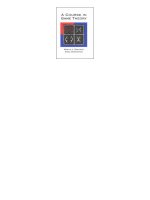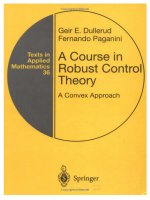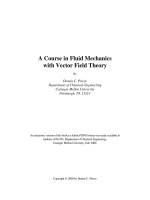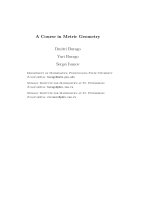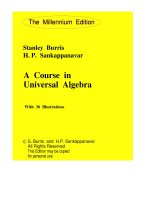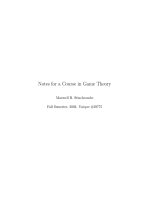A course in phonetics LADEFOGED peter
Bạn đang xem bản rút gọn của tài liệu. Xem và tải ngay bản đầy đủ của tài liệu tại đây (10.1 MB, 339 trang )
THE INTERNATIONAL PHONETIC ALPHABET (revised to 2005)
CONSONANTS (PULMONIC)
© 2005 IPA
Bilabial Labiodental
Plosive
Nasal
Trill
p b
m
ı
Dental
M
F B
f
v
Lateral
fricative
d
n
r
|
T D s z
Ò L
Post alveolar
t
Tap or Flap
Fricative
Alveolar
√
Approximant
Lateral
approximant
Retroflex
†
Palatal
∂ c
=
Velar
Uvular
«
Ω C
J x V X ‰
®
’
j
Â
l
¥
˚
S
Z
ß
Pharyngeal
Ô k g q G
≠
N
–
R
Glottal
/
©
?
h H
Where symbols appear in pairs, the one to the right represents a voiced consonant. Shaded areas denote articulations judged impossible.
CONSONANTS (NON-PULMONIC)
Clicks
>
ñ
<
¯
Ñ
Bilabial
Dental
(Post) alveolar
Palato alveolar
Alveolar lateral
Voiced implosives
∫
Î
˙
ƒ
Ï
Bilabial
Dental/alveolar
Palatal
Velar
Uvular
Ejectives
'
p'
t'
k'
s'
Examples:
Bilabial
Dental/alveolar
Velar
Alveolar fricative
(Continued on inside back cover)
Copyright 2010 Cengage Learning, Inc. All Rights Reserved. May not be copied, scanned, or duplicated, in whole or in part.
A Course in Phonetics
Copyright 2010 Cengage Learning, Inc. All Rights Reserved. May not be copied, scanned, or duplicated, in whole or in part.
Copyright 2010 Cengage Learning, Inc. All Rights Reserved. May not be copied, scanned, or duplicated, in whole or in part.
A Course in
Phonetics
Sixth Edition
PETER LADEFOGED
Late, University of California, Los Angeles
KEITH JOHNSON
University of California, Berkeley
Australia • Brazil • Japan • Korea • Mexico • Singapore • Spain • United Kingdom • United States
Copyright 2010 Cengage Learning, Inc. All Rights Reserved. May not be copied, scanned, or duplicated, in whole or in part.
A Course in Phonetics, Sixth
Edition
Peter Ladefoged and Keith
Johnson
Publisher: Michael Rosenberg
Development Editor: Joan M.
Flaherty
Assistant Editor: Jillian D’Urso
© 2011, 2006, 2001 Wadsworth, Cengage Learning
ALL RIGHTS RESERVED. No part of this work covered by the
copyright herein may be reproduced, transmitted, stored, or used
in any form or by any means graphic, electronic, or mechanical,
including but not limited to photocopying, recording, scanning,
digitizing, taping, Web distribution, information networks, or
information storage and retrieval systems, except as permitted
under Section 107 or 108 of the 1976 United States Copyright Act,
without the prior written permission of the publisher.
Editorial Assistant: Erin Pass
Media Editor: Amy Gibbons
Marketing Manager: Christina
Shea
Marketing Coordinator: Ryan
Ahern
Marketing Communications
Manager: Laura Localio
Content Project Manager:
Rosemary Winfield
Art Director: Cate Rickard Barr
Print Buyer: Betsy Donaghey
Text Permissions Manager:
Margaret Chamberlain-Gaston
Production Service:
Pre-PressPMG
For product information and
technology assistance, contact us at Cengage Learning
Customer & Sales Support, 1-800-354-9706.
For permission to use material from this text or product,
submit all requests online at www.cengage.com/permissions.
Further permissions questions can be emailed to
Library of Congress Control Number: 2009938969
ISBN-13: 9781428231269
ISBN-10: 1-4282-3126-9
Wadsworth
20 Channel Center Street
Boston, MA 02210
USA
Photo Manager: John Hill
Cover Designer: Lisa Devenish
Compositor: Pre-PressPMG
Cengage Learning is a leading provider of customized learning
solutions with office locations around the globe, including
Singapore, the United Kingdom, Australia, Mexico, Brazil and Japan.
Locate your local office at international.cengage.com/region.
Cengage Learning products are represented in Canada by
Nelson Education, Ltd.
For your course and learning solutions, visit
www.cengage.com.
Purchase any of our products at your local college store or at our
preferred online store www.ichapters.com.
Printed in Canada
1 2 3 4 5 6 7 13 12 11 10 09
Copyright 2010 Cengage Learning, Inc. All Rights Reserved. May not be copied, scanned, or duplicated, in whole or in part.
This book has always been for
Lise
Thegn
Katie
This edition is dedicated to Jenny.
Copyright 2010 Cengage Learning, Inc. All Rights Reserved. May not be copied, scanned, or duplicated, in whole or in part.
Contents
Preface
x
PART I: INTRODUCTORY CONCEPTS 1
CHAPTER 1
Articulation and Acoustics
2
Speech Production 2
Sound Waves 6
Places of Articulatory Gestures 8
The Oro-Nasal Process 13
Manners of Articulation 14
Stop 14
Oral Stop 14
Nasal Stop 14
Fricative 14
Approximant 15
Lateral (Approximant) 15
Additional Consonantal Gestures 15
The Waveforms of Consonants 17
The Articulation of Vowel Sounds 19
The Sounds of Vowels 21
Suprasegmentals 23
Exercises 29
CHAPTER 2
Phonology and Phonetic Transcription
33
The Transcription of Consonants 35
The Transcription of Vowels 38
Consonant and Vowel Charts 42
Phonology 45
Exercises 48
Performance Exercises 52
vi
Copyright 2010 Cengage Learning, Inc. All Rights Reserved. May not be copied, scanned, or duplicated, in whole or in part.
CONTENTS
vii
PART II ENGLISH PHONETICS 55
CHAPTER 3
The Consonants of English
Stop Consonants
56
57
Fricatives 65
Affricates 67
Nasals 67
Approximants 68
Overlapping Gestures 69
Rules for English Consonant Allophones
Diacritics 77
Exercises 77
Performance Exercises 82
CHAPTER 4
English Vowels
72
85
Transcription and Phonetic Dictionaries 85
Vowel Quality 87
The Auditory Vowel Space 88
American and British Vowels 89
Diphthongs 92
Rhotic Vowels 94
Unstressed Syllables 96
Tense and Lax Vowels 98
Rules for English Vowel Allophones 100
Exercises 102
Performance Exercises 105
CHAPTER 5
English Words and Sentences
107
Words in Connected Speech 107
Stress 111
Degrees of Stress 113
Sentence Rhythm 116
Intonation 118
Target Tones 127
Exercises 131
Performance Exercises 134
Copyright 2010 Cengage Learning, Inc. All Rights Reserved. May not be copied, scanned, or duplicated, in whole or in part.
viii
CONTENTS
PART III GENERAL PHONETICS 135
CHAPTER 6
Airstream Mechanisms and Phonation Types
136
Airstream Mechanisms
136
States of the Glottis 148
Voice Onset Time 151
Summary of Actions of the Glottis
Exercises 157
Performance Exercises 160
CHAPTER 7
Consonantal Gestures
156
163
Articulatory Targets 163
Types of Articulatory Gestures 172
Stops 172
Nasals 174
Fricatives 174
Trills, Taps, and Flaps 175
Laterals 178
Summary of Manners of Articulation
Exercises 181
Performance Exercises 183
CHAPTER 8
Acoustic Phonetics
180
187
Source/Filter Theory 187
Tube Models 190
Perturbation Theory 192
Acoustic Analysis 193
Acoustics of Consonants 198
Interpreting Spectrograms 204
Individual Differences 212
Exercises 215
CHAPTER 9
Vowels and Vowel-like Articulations
217
Cardinal Vowels 217
Secondary Cardinal Vowels 222
Vowels in Other Accents of English
224
Copyright 2010 Cengage Learning, Inc. All Rights Reserved. May not be copied, scanned, or duplicated, in whole or in part.
CONTENTS
ix
Vowels in Other Languages 226
Advanced Tongue Root 228
Rhotacized Vowels 229
Nasalization 231
Summary of Vowel Quality 232
Semivowels 232
Secondary Articulatory Gestures 234
Exercises 237
Performance Exercises 238
CHAPTER 10
Syllables and Suprasegmental Features
243
Syllables 243
Stress 249
Length 251
Timing 252
Intonation and Tone 254
Stress, Tone, and Pitch Accent Languages
Exercises 261
Performance Exercises 263
CHAPTER 11
Linguistic Phonetics
260
267
Phonetics of the Community and of the Individual
The International Phonetic Alphabet 268
Feature Hierarchy 272
A Problem with Linguistic Explanations 277
Controlling Articulatory Movements 278
Memory for Speech 281
The Balance between Phonetic Forces 284
Performance Exercises 286
267
Appendix A: Additional Material for Transciption 293
Appendix B: Suggestions for Contributors to the Journal of the International
Phonetic Association 295
Notes 299
Glossary 305
Further Reading 313
Index 317
Copyright 2010 Cengage Learning, Inc. All Rights Reserved. May not be copied, scanned, or duplicated, in whole or in part.
Preface
The sixth edition marks a transition in A Course in Phonetics. This is the first edition to appear since the death of Peter Ladefoged. When I was asked by his widow
Jenny Ladefoged and publisher Michael Rosenberg to produce this new edition of
the Course, I was honored but also quite daunted. Through five editions, this book
has been an almost ideal tool for teaching phonetics. When you start from such a
high point, there is a lot of room to go down and not much room to go up.
As in previous editions of this book, there is an introduction to how speech is
produced, a description of speech in acoustic terms, and instruction in practical
phonetic skills. These approaches all use phonetic transcription. Whether you are
a speech pathologist, an opera singer, a linguist, an actor, or any other student of
speech, you need to be able to represent the sounds of speech by using the symbols
of the International Phonetic Alphabet (IPA). This is the accepted way of recording
observations of what people say. Ordinary spelling does not allow you to represent
all the subtle variations that occur when different people talk. Learning to use the
IPA symbols is an essential part of phonetics.
One of the main changes in this new edition is that the sections on acoustic
phonetics and speech motor control go deeper than those in the fifth edition did.
The aim of the acoustic phonetics sections is to help students use widely available
tools for digitally inspecting and manipulating speech. However, instructors who
prefer the traditional system of teaching only articulatory phonetics to start will
still find it possible to do so by simply skipping the acoustics sections. Inclusion
of new material on speech motor control is meant to provide a firmer foundation for the understanding of speech production, and the performance exercises
in each chapter provide a framework for students to practice the sounds of the
world’s languages.
In this edition, the discussion of phonetics as a subdiscipline of linguistics has
been reframed to focus on how speech style impacts linguistic description and on
the types of knowledge that we encounter in studying phonetics. Although some
instructors will not wish to emphasize a general theoretical framework for phonetics, we all (including our students) adopt a framework of some sort either implicitly
or explicitly. This book has always included, in Chapter 11, an explicit discussion
of how phonetics relates to general linguistics, and I’ve updated that discussion to
include the difference between private phonetic knowledge (the more cognitive aspects of phonetics) and public phonetic knowledge (aspects of phonetics that are
shared in a speech community). In this context, we can separate phonetic observations that are relevant for linguistic description from phonetic observations that may
have only an indirect bearing on language.
The text has also been updated and clarified in numerous other ways. For instance, the glottal stop is introduced earlier, Canadian raising is mentioned in
x
Copyright 2010 Cengage Learning, Inc. All Rights Reserved. May not be copied, scanned, or duplicated, in whole or in part.
PREFACE
xi
connection with flapping in English, the phonological status of [ ŋ ] in English is
placed in historical context, MRI images of vocal tracts are used to illustrate some
speech sounds (where the previous edition relied exclusively on x-ray tracings), and
examples of real conversational speech are used to illustrate English sentences. You
will find many other such small changes.
Part of what makes the Course such a great book is its authoritativeness. During
his lifetime, Peter Ladefoged was rightfully described as the world’s greatest living phonetician, and now it can be safely said that he was one of the greatest and
most important phoneticians ever. The authoritativeness of the Course derives from
Peter’s extensive fieldwork around the world. Almost all of the examples that you
will find in this book were recorded by him personally as he worked with native
speakers of the languages illustrated. His rigorously scientific approach to studying
the phonetic properties of speech sounds (see his book Phonetic Data Analysis: An
Introduction to Fieldwork and Instrumental Techniques) provides a foundation for
the observations presented in the book and greatly enriched our understanding of
phonetics around the world. All of this information is retained in this edition and,
where appropriate, I have updated and expanded it.
The second main ingredient that makes this such a great book is that it is studentfriendly. Peter and Jenny Ladefoged worked as a team to ensure that the esoteric
material of sagittal sections, gestures, and sound waves was presented in a way that
is both engaging and understandable. A key student-friendly feature of the book that
has been retained for this edition is the accompanying CD of recorded audio files.
Icons in the margins of this book indicate corresponding material on the CD.
A COURSE IN PHONETICS CD-ROM
The CD that accompanies A Course in Phonetics, which was originally produced
mainly by Jenny Ladefoged for the fifth edition, contains recorded examples of
speech sounds and intonation patterns that are keyed to discussion in the book. It is
an essential tool for studying phonetics. I have added a few new examples to the CD
and converted the audio files into the more widely used WAV format.
The CD has a wealth of material that is integral to a good understanding of phonetics, and it is easy to navigate. Clicking on the title A Course in Phonetics on the
title page of the CD leads to the list of contents. Clicking on the first entry, “IPA,”
leads to the chart of the complete International Phonetic Alphabet and to pronunciations that are associated with every sound. Every chapter of this book has links to
sections that provide data for that chapter (corresponding to CD icons in the margins
of the book). Clicking the chapter title leads to recordings of nearly all the words in
the tables and many of the examples cited in the text. Clicking the other links leads
to the exercises in the book, including the performance exercises that afford practice in making the sounds of language. The CD also includes an index of languages
(nearly 100) so that you can look up a language and hear its sounds. The index of
sounds lists sounds by name (e.g., creaky voice, clicks in Zulu) that lead to recordings of those sounds. Clicking “Map Index” leads to a world map with links to maps
of individual regions that indicate the languages spoken there and lead to recordings
of the sounds of those languages.
Copyright 2010 Cengage Learning, Inc. All Rights Reserved. May not be copied, scanned, or duplicated, in whole or in part.
xii
PREFACE
ACKNOWLEDGMENTS
Numerous people have contributed to this book. In producing previous editions
of this book, Peter Ladefoged was particularly influenced and helped by Ian
Maddieson, Pat Keating, Bruce Hayes, Sun-Ah Jun, and Louis Goldstein; their
influence is still apparent in this edition. Discussions with my colleagues Larry
Hyman, Andrew Garrett, and Sharon Inkelas have been very helpful. And useful
reviews were provided by
Lisa Davidson, New York University
Douglas Pulleyblank, University of British Columbia
Julia Roberts, University of Vermont
Dwan Shipley, Western Washington University, Bellingham
I am also indebted to Karen Judd, Michael Rosenberg, Joan Flaherty, Jill D’Urso,
and Rosemary Winfield of Wadsworth/Cengage Learning, and to Andrew Tremblay of
Pre-PressPMG for excellent book production and copy editing. Assistance from many
other people is acknowledged in the “Notes” section at the back of this book.
Copyright 2010 Cengage Learning, Inc. All Rights Reserved. May not be copied, scanned, or duplicated, in whole or in part.
About the Authors
Peter Ladefoged (1925–2006) was preeminent in
the field of phonetics. He received his Ph.D. from
the University of Edinburgh, Scotland, in 1958.
He founded the UCLA Phonetics Laboratory and
was its director from 1962 to 1991 while he was
also a professor in the Department of Linguistics.
His contributions to the discipline of linguistics
are enormous and have furthered our knowledge
of language and languages in many ways. His
phonetics fieldwork (pre-computers) took him
around the globe, carrying equipment to record,
document, and describe little-known languages.
He catalogued the sounds of thousands of languages. Ladefoged also experimented with and
encouraged the development of better scientific
research methods and equipment. He was instrumental in revising the IPA to include
more sounds and advocated for preservation of endangered languages. In his spare
time, he consulted on forensics cases and even served as a dialect adviser and lent
his voice to the film My Fair Lady.
Peter will be remembered for his outstanding contributions to phonetics and linguistics, and also for his lively and impassioned teaching, and his service as mentor
to a great number of doctoral students and to his junior colleagues. Many careers
have been built on his influence, enthusiasm, and encouragement.
Keith Johnson taught phonetics in the Department
of Linguistics at Ohio State University from 1993
to 2005 and is now a professor in the Department
of Linguistics at the University of California,
Berkeley. He is the author of Acoustic and Auditory Phonetics and Quantitative Linguistics. His
Ph.D. is from Ohio State University, and he held
postdoctoral training fellowships at Indiana University (with David Pisoni) and at UCLA (with
Peter Ladefoged and Pat Keating).
xiii
Copyright 2010 Cengage Learning, Inc. All Rights Reserved. May not be copied, scanned, or duplicated, in whole or in part.
Copyright 2010 Cengage Learning, Inc. All Rights Reserved. May not be copied, scanned, or duplicated, in whole or in part.
PART I
INTRODUCTORY CONCEPTS
Copyright 2010 Cengage Learning, Inc. All Rights Reserved. May not be copied, scanned, or duplicated, in whole or in part.
1
Articulation and Acoustics
Phonetics is concerned with describing speech. There are many different reasons
for wanting to do this, which means that there are many kinds of phoneticians.
Some are interested in the different sounds that occur in languages. Some are
more concerned with pathological speech. Others are trying to help people speak
a particular form of English. Still others are looking for ways to make computers
talk more intelligibly or to get computers to recognize speech. For all these purposes, phoneticians need to find out what people are doing when they are talking
and how the sounds of speech can be described.
SPEECH PRODUCTION
CD 1.1
We will begin by describing how speech sounds are made. Most of them are
the result of movements of the tongue and the lips. We can think of these movements as gestures forming particular sounds. We can convey information by gestures of our hands that people can see, but in making speech that people can
hear, humans have found a marvelously efficient way to impart information. The
gestures of the tongue and lips are made audible so that they can be heard and
recognized.
Making speech gestures audible involves pushing air out of the lungs while
producing a noise in the throat or mouth. These basic noises are changed by
the actions of the tongue and lips. Later, we will study how the tongue and lips
make about twenty-five different gestures to form the sounds of English. We can
see some of these gestures by looking at an x-ray movie (which you can watch
on the CD that accompanies this book). Figure 1.1 shows a series of frames
from an x-ray movie of the phrase on top of his deck. In this sequence of twelve
frames (one in every four frames of the movie), the tongue has been outlined to
make it clearer. The lettering to the right of the frames shows, very roughly, the
sounds being produced. The individual frames in the figure show that the tongue
and lips move rapidly from one position to another. To appreciate how rapidly
the gestures are being made, however, you should watch the movie on the CD.
Demonstration 1.1 plays the sounds and shows the movements involved in the
phrase on top of his deck. Even in this phrase, spoken at a normal speed, the
tongue is moving quickly. The actions of the tongue are among the fastest and
most precise physical movements that people can make.
2
Copyright 2010 Cengage Learning, Inc. All Rights Reserved. May not be copied, scanned, or duplicated, in whole or in part.
Speech Production
Figure 1.1
3
Frames from an x-ray movie of a speaker saying on top of his deck.
o
1
’is
25
n
5
d
29
t
9
e
34
o
13
ck
37
p
17
k
41
of
21
-
45
Copyright 2010 Cengage Learning, Inc. All Rights Reserved. May not be copied, scanned, or duplicated, in whole or in part.
4
CD 1.2
CD 1.3
CHAPTER 1 Articulation and Acoustics
Producing any sound requires energy. In nearly all speech sounds, the basic
source of power is the respiratory system pushing air out of the lungs. Try to talk
while breathing in instead of out. You will find that you can do it, but it is much
harder than talking when breathing out. When you talk, air from the lungs goes up
the windpipe (the trachea, to use the more technical term) and into the larynx, at
which point it must pass between two small muscular folds called the vocal folds. If
the vocal folds are apart (as yours probably are right now while you are breathing in
and out), the air from the lungs will have a relatively free passage into the pharynx
and the mouth. But if the vocal folds are adjusted so that there is only a narrow passage between them, the airstream from the lungs will set them vibrating. Sounds
produced when the vocal folds are vibrating are said to be voiced, as opposed to
those in which the vocal folds are apart, which are said to be voiceless.
In order to hear the difference between a voiced and a voiceless sound,
try saying a long ‘v’ sound, which we will symbolize as [ vvvvv ]. Now
compare this with a long ‘f ’ sound [ fffff ], saying each of them alternately—
[ fffffvvvvvfffffvvvvv ]. (As indicated by the symbol in the margin, this sequence
is on the accompanying CD.) Both of these sounds are formed in the same way
in the mouth. The difference between them is that [ v ] is voiced and [ f ] is voiceless. You can feel the vocal fold vibrations in [ v ] if you put your fingertips
against your larynx. You can also hear the buzzing of the vibrations in [ v ] more
easily if you stop up your ears while contrasting [ fffffvvvvv ].
The difference between voiced and voiceless sounds is often important in distinguishing sounds. In each of the pairs of words fat, vat; thigh, thy; Sue, zoo,
the first consonant in the first word of each pair is voiceless; in the second word,
it is voiced. To check this for yourself, say just the consonant at the beginning of
each of these words and try to feel and hear the voicing as suggested above. Try
to find other pairs of words that are distinguished by one having a voiced and the
other having a voiceless consonant.
The air passages above the larynx are known as the vocal tract. Figure 1.2
shows their location within the head (actually, within Peter Ladefoged’s head, in
a photograph taken many years ago). The shape of the vocal tract is a very important factor in the production of speech, and we will often refer to a diagram
of the kind that has been superimposed on the photograph in Figure 1.2. Learn
to draw the vocal tract by tracing the diagram in this figure. Note that the air
passages that make up the vocal tract may be divided into the oral tract, within
the mouth and pharynx, and the nasal tract, within the nose. When the flap at the
back of the mouth is lowered (as it probably is for you now, if you are breathing with your mouth shut), air goes in and out through the nose. Speech sounds
such as [ m ] and [ n ] are produced with the vocal folds vibrating and air going
out through the nose. The upper limit of the nasal tract has been marked with a
dotted line since the exact boundaries of the air passages within the nose depend
on soft tissues of variable size.
The parts of the vocal tract that can be used to form sounds, such as the tongue
and the lips, are called articulators. Before we discuss them, let’s summarize
Copyright 2010 Cengage Learning, Inc. All Rights Reserved. May not be copied, scanned, or duplicated, in whole or in part.
Speech Production
Figure 1.2
5
The vocal tract.
the speech production mechanism as a whole. Figure 1.3 shows the four main
components—the airstream process, the phonation process, the oro-nasal process, and the articulatory process. The airstream process includes all the ways of
pushing air out (and, as we will see later, of sucking it in) that provide the power
for speech. For the moment, we have considered just the respiratory system, the
lungs pushing out air, as the prime mover in this process. The phonation process
is the name given to the actions of the vocal folds. Only two possibilities have
been mentioned: voiced sounds in which the vocal folds are vibrating and voiceless sounds in which they are apart. The possibility of the airstream going out
through the mouth, as in [ v ] or [ z ], or the nose, as in [ m ] and [ n ], is determined
by the oro-nasal process. The movements of the tongue and lips interacting with
the roof of the mouth and the pharynx are part of the articulatory process.
Copyright 2010 Cengage Learning, Inc. All Rights Reserved. May not be copied, scanned, or duplicated, in whole or in part.
6
CHAPTER 1 Articulation and Acoustics
Figure 1.3
The four main components of the speech mechanism.
oro-nasal
process
articulatory
process
phonation
process
airstream
process
SOUND WAVES
So far, we have been describing speech sounds by stating how they are made,
but it is also possible to describe them in terms of what we can hear. The way in
which we hear a sound depends on its acoustic structure. We want to be able to
describe the acoustics of speech for many reasons (for more on acoustic phonetics, see Keith Johnson’s book Acoustic and Auditory Phonetics). Linguists and
speech pathologists need to understand how certain sounds become confused
with one another. We can give better descriptions of some sounds (such as vowels) by describing their acoustic structures rather than by describing the articulatory movements involved. A knowledge of acoustic phonetics is also helpful
for understanding how computers synthesize speech and how speech recognition
works (topics that are addressed more fully in Peter Ladefoged’s book Vowels
and Consonants). Furthermore, often the only permanent data that we can get of
a speech event is an audio recording, as it is often impossible to obtain movies or
Copyright 2010 Cengage Learning, Inc. All Rights Reserved. May not be copied, scanned, or duplicated, in whole or in part.
Sound Waves
7
x-rays showing what the speaker is doing. Accordingly, if we want permanent data
that we can study, it will often have to come from analyzing an audio recording.
Speech sounds, like other sounds, can differ from one another in three ways.
They can be the same or different in (1) pitch, (2) loudness, and (3) quality. Thus,
two vowel sounds may have exactly the same pitch in the sense that they are said
on the same note on the musical scale, and they may have the same loudness, yet
still may differ in that one might be the vowel in bad and the other the vowel in
bud. On the other hand, they might have the same vowel quality but differ in that
one was said on a higher pitch or that one of them was spoken more loudly.
Sound consists of small variations in air pressure that occur very rapidly one
after another. These variations are caused by actions of the speaker’s vocal organs that are (for the most part) superimposed on the outgoing flow of lung
air. Thus, in the case of voiced sounds, the vibrating vocal folds chop up the
stream of lung air so that pulses of relatively high pressure alternate with moments of lower pressure. Variations in air pressure in the form of sound waves
move through the air somewhat like the ripples on a pond. When they reach the
ear of a listener, they cause the eardrum to vibrate. A graph of a sound wave is
very similar to a graph of the movements of the eardrum.
The upper part of Figure 1.4 shows the variations in air pressure that occur
during Peter Ladefoged’s pronunciation of the word father. The ordinate (the
vertical axis) represents air pressure (relative to the normal surrounding air pressure), and the abscissa (the horizontal axis) represents time (relative to an arbitrary starting point). As you can see, this particular word took about 0.6 seconds
to say. The lower part of the figure shows part of the first vowel in father. The
major peaks in air pressure recur about every 0.01 seconds (that is, every onehundredth of a second). This is because the vocal folds were vibrating approximately one hundred times a second, producing a pulse of air every hundredth of
a second. This part of the diagram shows the air pressure corresponding to four
vibrations of the vocal folds. The smaller variations in air pressure that occur
within each period of one-hundredth of a second are due to the way air vibrates
when the vocal tract has the particular shape required for this vowel.
In the upper part of Figure 1.4, which shows the waveform for the whole
word father, the details of the variations in air pressure are not visible because
the time scale is too compressed. All that can be seen are the near-vertical lines
corresponding to the individual pulses of the vocal folds. The sound [ f ] at
the beginning of the word father has a low amplitude (it is not very loud, so the
pressure fluctuation is not much different from zero) in comparison with the following vowel, and the variations in air pressure are smaller and more nearly random. There are no regular pulses because the vocal folds are not vibrating. We
will be considering waveforms and their acoustic analysis in more detail later
in this book. For the moment, we will simply notice the obvious difference between sounds in which the vocal folds are vibrating (which have comparatively
large regular pulses of air pressure) and sounds without vocal fold vibration
(which have a smaller amplitude and irregular variations in air pressure).
Copyright 2010 Cengage Learning, Inc. All Rights Reserved. May not be copied, scanned, or duplicated, in whole or in part.
8
CHAPTER 1 Articulation and Acoustics
Figure 1.4
The variations in air pressure that occur during Peter Ladefoged’s
pronunciation of the vowel in father.
0.0
0.2
f
expanded
0.0
0.4
a
this
0.01
0.6 s
th
part
0.02
er
expanded
0.03
0.04 s
PLACES OF ARTICULATORY GESTURES
The parts of the vocal tract that can be used to form sounds are called
articulators. The articulators that form the lower surface of the vocal tract are
highly mobile. They make the gestures required for speech by moving toward
the articulators that form the upper surface. Try saying the word capital and
note the major movements of your tongue and lips. You will find that the back
of the tongue moves up to make contact with the roof of the mouth for the first
sound and then comes down for the following vowel. The lips come together
in the formation of p and then come apart again in the vowel. The tongue tip
comes up for the t and again, for most people, for the final l.
The names of the principal parts of the upper surface of the vocal tract are
given in Figure 1.5. The upper lip and the upper teeth (notably the frontal incisors) are familiar-enough structures. Just behind the upper teeth is a small protuberance that you can feel with the tip of the tongue. This is called the alveolar
ridge. You can also feel that the front part of the roof of the mouth is formed
Copyright 2010 Cengage Learning, Inc. All Rights Reserved. May not be copied, scanned, or duplicated, in whole or in part.
Places of Articulatory Gestures
Figure 1.5
9
The principal parts of the upper surface of the vocal tract.
by a bony structure. This is the hard palate. You will probably have to use a
fingertip to feel farther back. Most people cannot curl the tongue up far enough
to touch the soft palate, or velum, at the back of the mouth. The soft palate is a
muscular flap that can be raised to press against the back wall of the pharynx and
shut off the nasal tract, preventing air from going out through the nose. In this
case, there is said to be a velic closure. This action separates the nasal tract from
the oral tract so that the air can go out only through the mouth. At the lower end
of the soft palate is a small appendage hanging down that is known as the uvula.
The part of the vocal tract between the uvula and the larynx is the pharynx.
The back wall of the pharynx may be considered one of the articulators on the
upper surface of the vocal tract.
Figure 1.6 shows the lower lip and the specific names for the parts of the
tongue that form the lower surface of the vocal tract. The tip and blade of the
tongue are the most mobile parts. Behind the blade is what is technically called
the front of the tongue; it is actually the forward part of the body of the tongue
and lies underneath the hard palate when the tongue is at rest. The remainder of
the body of the tongue may be divided into the center, which is partly beneath
the hard palate and partly beneath the soft palate; the back, which is beneath the
soft palate; and the root, which is opposite the back wall of the pharynx. The
epiglottis is attached to the lower part of the root of the tongue.
Bearing all these terms in mind, say the word peculiar and try to give a rough
description of the gestures made by the vocal organs during the consonant
sounds. You should find that the lips come together for the first sound. Then the
back and center of the tongue are raised. But is the contact on the hard palate or
on the velum? (For most people, it is centered between the two.) Then note the
position in the formation of the l. Most people make this sound with the tip of
the tongue on the alveolar ridge.
Copyright 2010 Cengage Learning, Inc. All Rights Reserved. May not be copied, scanned, or duplicated, in whole or in part.
